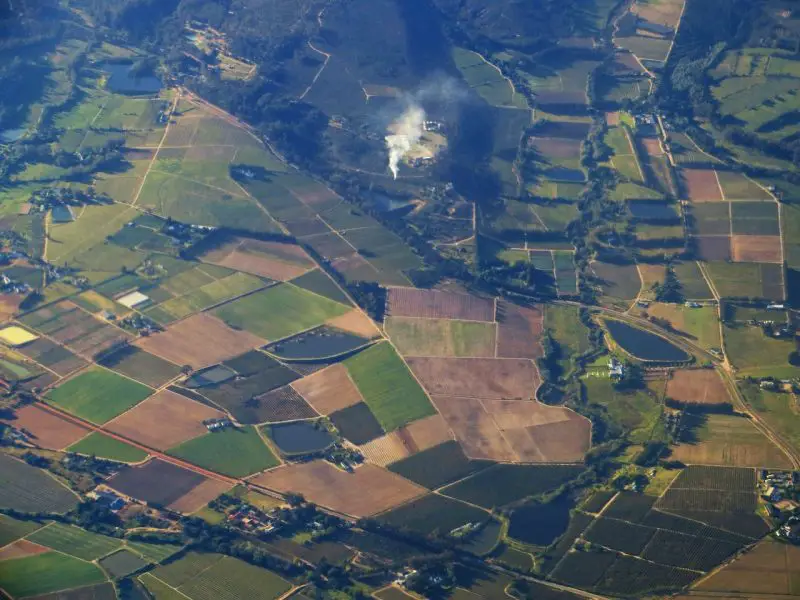There are 640 acres in a square mile. Since an acre is a measure of area, and a mile is a measure of distance, the mile has to be squared to become a unit of area, too.
Read on to find out more.
“How Many Acres in a Mile?”
An acre is a unit of measure typically used to measure land area. A mile is a unit of measure for length, typically used to measure the distance between one land area and another.
So, to find out how much land area constitutes another land area, the measure of distance has to be converted into a measure of land area, too.
Think of an acre as a handkerchief, and a mile as a rope laid out straight on the ground. We can line up 640 handkerchiefs along the rope and say that it takes 640 handkerchiefs to complete the rope line. What if we run out of rope before we run out of handkerchiefs? Does this mean that the rope (mile) is made up of less than 640 handkerchiefs (acres)?
Not necessarily, as the 640 handkerchiefs can also be lined up in horizontal rows of 10, making only 64 rows lining up with the rope. They can also be lined up in horizontal rows of 64, making only 10 rows lining up with the rope. What if we still have a lot of rope left after doing either of these? Does this mean that the rope (mile) is made up of more than 640 handkerchiefs (acres)?
No. It just means that we wrongly paired the area with the distance.
What we can do, instead, is to have the rope squared, forming an enclosure, to find out exactly how many handkerchiefs can fit into the squared enclosure. In this way, we are pairing the area of the rope (square mile) with the area covered by the 640 handkerchiefs (acres).
Therefore, the more correct question should be: “How many acres are there in a square mile?“
An acre is 43,560 square feet. A square mile is 27,878,400 square feet.
To find out how many acres would fit in a square mile, divide 27,878,400 by 43,560 and you get the quotient of 640.
So, there are 640 acres in a square mile.

How Many Acres in 10 Square Miles?
To find out how many acres would fit into 10 square miles, simply multiply 640 by 10 and you get the product of 6,400.
So, there are 6,400 acres in 10 square miles.
Many Acres
However, it’s not as simple as it looks.
An acre is a measure of land area used in the Imperial and U.S. systems, based on the 1959 international yard and pound agreement between the U.S. and 5 Commonwealth countries — Australia, Canada, New Zealand, South Africa, and the United Kingdom.
When we said that an acre is 43,560 feet, we were talking about the Imperial and U.S. –or international– acre. But there are many other types of acres:
- U.S. survey acre is 4,046.872 square meters, larger than the international acre which is at 4,046.86 square meters (or, at 43,560.17 square feet, it is larger than the international acre by 0.17 square feet).
- Customary acre is roughly similar to the Imperial acre with local UK variations.
- Builder’s acre is an even 40,000 square feet, used in the real estate industry in the U.S. It is almost 10% smaller than the survey acre, and which discrepancy has caused lawsuits for misrepresentation (so when your real estate developer tries to sell you an acre, ask if it’s the international or survey acre, or their builders’ acre).
- Town acre was used in the early 19th century for planning towns on a grid plan, such as in Adelaide, South Australia, and Nelson, New Plymouth, and Wellington in New Zealand. The land was divided into plots of an Imperial acre, which became known as “town acres”.
- Roman acre or actus quadratus is 14,400 square Roman feet (at around1,260 square meters, it is a third of the international acre).
- The Cheshire acre is 10,240 square yards, or 8,560 square meters (at 92,139.07 square feet, it is twice larger than the international acre).
- Greek acre or stremma is 10,000 square Greek feet but is now set at exactly 1,000 square meters (at 10,763.9 square feet, it is a fourth of the international acre).
- Irish acre is 7,840 square yards or 6,560 square meters (at 70,611.25 square feet, it is 1.62 times larger than the international acre).
- Scottish acre is 1.3 Imperial acres, or 5,080 square meters (at 54,680.66 square feet, it is 1.26 times larger than the international acre) but is now an obsolete Scottish measurement.
- Turkish acre or dunam is 1,600 square Turkish paces but is now set at exactly 1,000 square meters like the Greek acre or stremma.
- A long acre is the grass strip on either side of the road that may be used for illicit grazing.
- God’s acre is another name for a churchyard.

Many Miles
It gets more complex.
When we said that a square mile is 27,878,400 square feet, we were talking about the Imperial and U.S.– or the international– square miles and feet, too.
A square mile is an area equal to the area of a square with sides of 1 mile each.
It is not the same as a “miles square“, which is an area with each side having a length of the given value. For example, 20 miles square (20 miles x 20 miles) has an area of 400 square miles.
There are also different types of miles:
- Roman mile is 1,000 paces, or the total distance of the left foot hitting the ground 1,000 times. This is equivalent to 5,000 Roman feet after Agrippa who established a standard Roman foot (his own) in 29BC and defined a pace as 5 feet.
- Arabic mile was used by medieval scientists and geographers, which became a precursor to the geographical or nautical mile (1 minute of arc along the earth’s equator).
- Breslau mile was used in Breslau, Poland, and in all of Silesia from 1630 onwards, and is equivalent to 6,700 meters (21,981.63 feet) today.
- Croatian mile was first devised by the Jesuit Stjepan Glavac on a 1673 map and is equivalent to 11.13 kilometers (36,515.75 feet) today.
- The Dutch mile (mijl) has had several definitions throughout history, but when the Netherlands adopted the metric system in 1816, became synonymous with the kilometer or 1,000 meters (3,280.84 feet).
- English mile also varied over time and was superseded by the international mile in the 1959 international yard and pound agreement.
- German mile (meile) was set at 24,000 feet, after several variations (Austrian, Prussian, and Danish miles)
- Hungarian mile (merfold or magyar merfold) also varied before it was standardized at 8.3536 kilometers (27,406.82 feet).
- Irish mile was used from the 16th-century plantations up to the earlier part of the 20th century. It was 2.048 kilometers (6,719.16 feet).
- The Italian mile (miglio) was considered to be a direct continuation of the Roman mile of 1,000 paces, but it varied over time among different regions. Today, it is called the “geographical mile” which is different from the geographical mile as a separate, standard unit.
- Ottoman mile was 1,894.35 meters (6,215.06 feet), equal to 5,000 Ottoman feet. After 1933, it was replaced by the modern Turkish mile at 1,853.181 meters (6,079.99 feet).
- Portuguese mile (milha) was 2.0873 kilometers (6,848.10 feet) and was used in Brazil and Portugal before metrification.
- Russian mile was 7.468 kilometers (24,501.31 feet).
- The Saxon post mile, introduced on a survey of Saxon roads in the 1700s, was equivalent to 9.062 kilometers (29,730.97 feet)
- The Scots mile was equivalent to 1.81 kilometers (5,938.32 feet). It was mentioned by Robert Burns in the first verse of his poem, Tam’o Shanter. It was abolished 3 times: by a 1685 act of the Scottish parliament, by a 1707 Treaty of Union with England, and finally, by the Weights and Measures Act of 1824.
- Welsh mile (milltir or milldir) was equivalent to 6.17 kilometers (20,242.78 feet). Its use was discontinued after the conquest of Wales by the English under Edward I in the 13th century.
All this talk of many acres and many miles now gives new meaning to a line in Robert Frost’s poem, Stopping by Woods on a Snowy Evening —
The woods are lovely, dark, and deep,
But I have promises to keep,
And miles to go before I sleep,
And miles to go before I sleep.
Poetry Foundation
- What Size is Regular Printer Paper? Quick Guide for Paper Dimensions - June 18, 2023
- What Size is My Monitor: A Comprehensive Guide - June 18, 2023
- How Big is Italy Compared to the US? A Concise Comparison - June 16, 2023

